Page 75 of 324
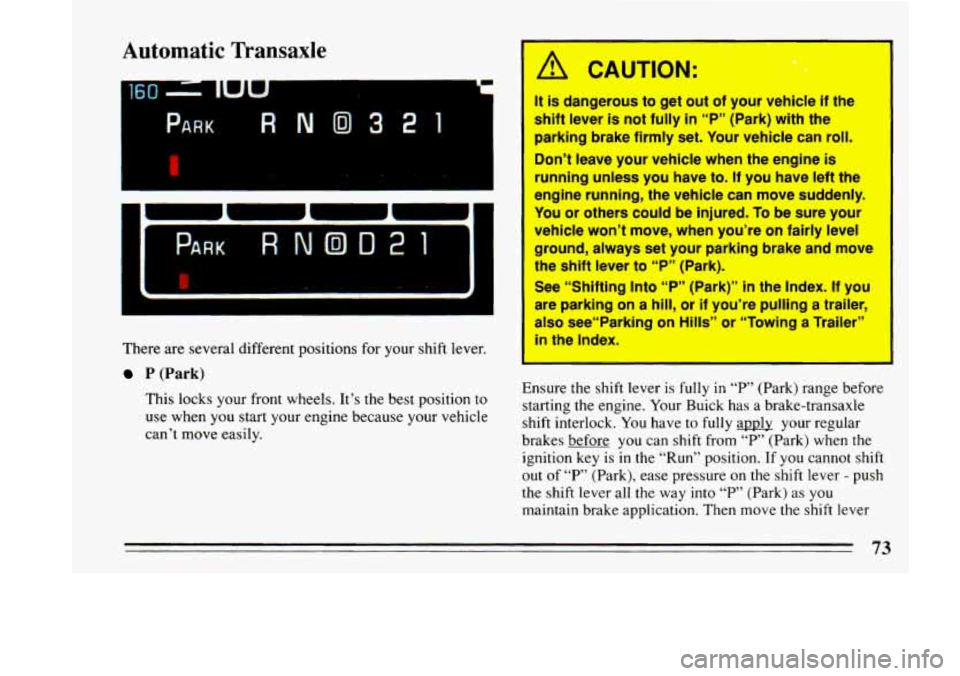
PARK RNO321
Automatic Transaxle
r
There are several different positions for your shift lever.
P (Park)
This locks your front wheels. It’s the best position to
use when you start your engine because your vehicle
can’t move easily.
A CAUTION: .
a -II
It is dangerous to get out of your vehicle If the
shift [ever is not fully in “P” (Park) with the
parking
brake firmly set. Your vehicle can roll.
Don’t leave your vehicle when ihe engine is
running unless you hsve to. If you have left the
engine
running, the vehicle can move suddenly.
You or others could be Injured. To be sure your
vehicle won’t move, when you’re on fairly level
ground, always set your parking brake and move
the shift lever to V“ (Park).
See “Shifting Into “P” (Park)” in the Index. If you
arb parkfng on a hill, or if you’re pulling a trailer,
also see“Parking on Hills” or “Towing a Trailer”
in’ the Index.
- i
Ensure the shift lever is fully in “F‘” (Park) range before
starting the engine. Your Buick has a brake-transaxle
shift interlock.
You have to fully apply your regular
brakes before
you can shift from “P” (Park) when the
ignition key is
in the “Run” position. If you cannot shift
out of “P” (Park), ease pressure on the shift lever - push
the shift lever all
the way into “P” (Park) as you
maintain brake application. Then move the shift lever
73
Page 77 of 324
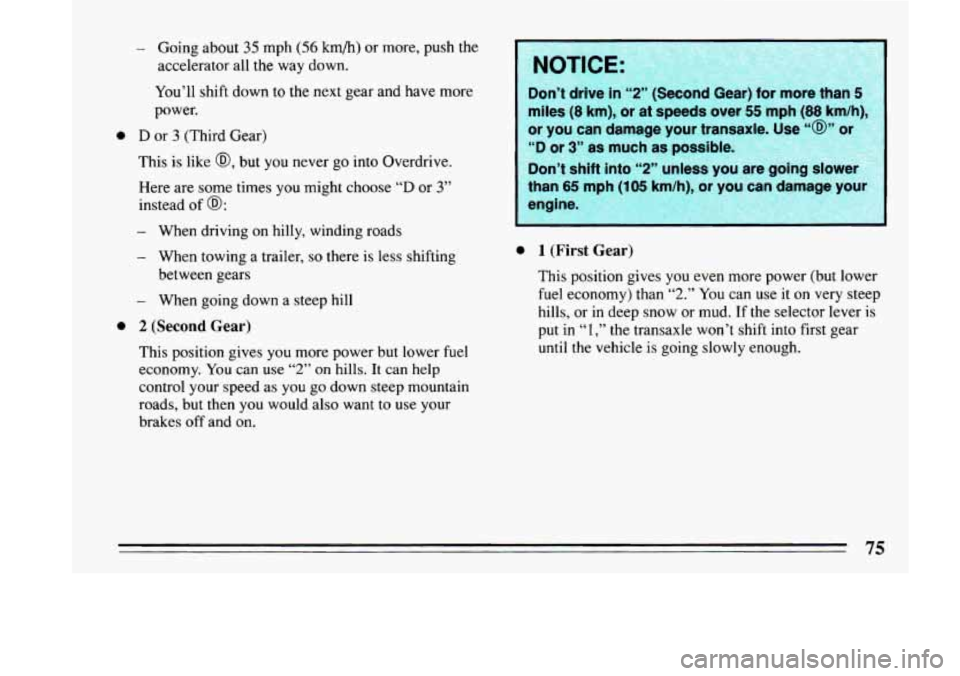
- Going about 35 mph (56 km/h) or more, push the
accelerator all the way down.
You’ll shift down to the next gear and have more
power.
0 D or 3 (Third Gear)
This is like
@, but you never go into Overdrive.
Here are some times you might choose
“D or 3”
instead of @:
- When driving on hilly, winding roads
- When towing a trailer, so there is less shifting
between gears
- When going down a steep hill
0 2 (Second Gear)
This position gives you more power but lower fuel
economy.
You can use “2” on hills. It can help
control your speed as you go down steep mountain
roads, but then you would also want to use your
brakes off and on.
NOTICE:
Don’t drive in “2” (S
or you can damage your trans
“D or 3” as much as possible.
e 1 (First Gear)
This position gives you even more power (but lower
fuel economy) than
“2.” You can use it on very steep
hills,
or in deep snow or mud. If the selector lever is
put in “1,” the transaxle won’t shift into first gear
until the vehicle is going slowly enough.
75
Page 79 of 324
1
To release the parking brake:
Hold the regular brake pedal down. Pull the brake
release lever.
If you try to drive more than
50 feet with the parking
brake
on, the brake light stays on and a chime sounds
until you release the parking brake or recycle the
ignition.
NOTICE
Driving with t
I
rear brakes to overheat. You may have to replace
them,
and you could also damage other parts
If you are on a hill: See “Parking on Hills” in the Index.
That section shows how to turn your front wheels.
If you are towing a trailer and are parking on any hill:
See “Towing a Trailer” in the Index. That section shows
what
to do first to keep the trailer from moving.
77
Page 80 of 324
Shifting Into cc P 99 (Park)
A CAUTION:
It can be dangerous to get out of your vehicle if
the shift lever is not fully In ‘6P’’ (Park) with the
parking brake firmly set. Your vehicle
can roll.
If you have left the*engine running, the vehicle
can move suddenly.
You or others could be
injured.
To be sure your vehicle won’t move,
when you’re on fairly level ground, use the steps
that
follow. If you are parking on a hill, or if
you’re pulling
a trailer, also see “Parking On
Hills” or “Towing a Trailer” in the Index.
1
1. Hold the brake pedal down with your right foot and
2. Move the shift lever into “P” (Park) position like
set the parking brake.
this:
Pull the lever toward you.
Page 84 of 324
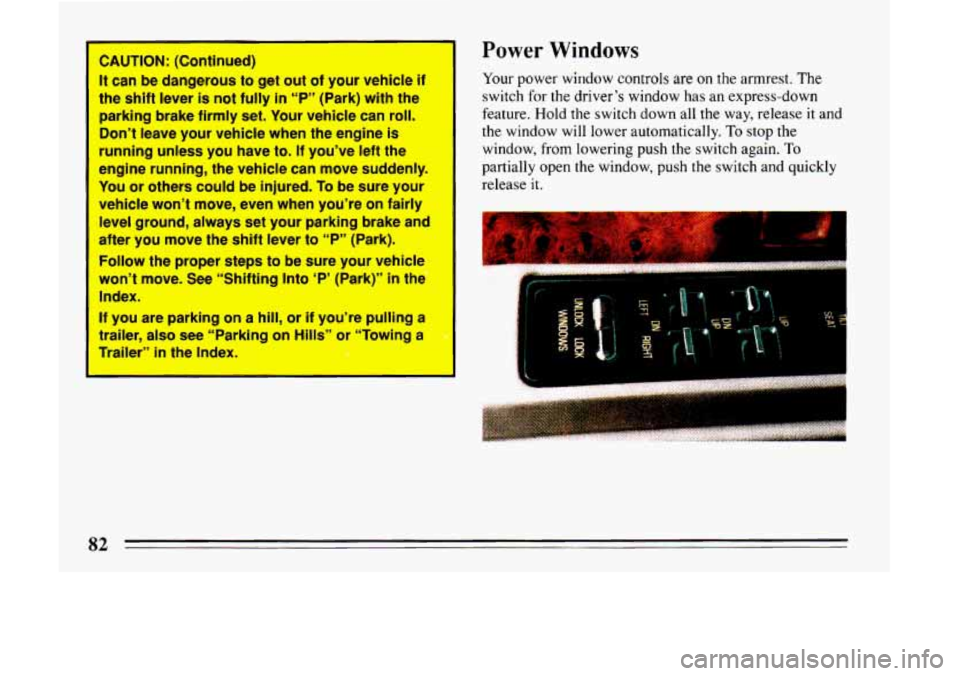
CAUTION: (Continued)
It can be dangerous to get out of your vehicle if
the shift lever
is not fully in “P’ (Park) with the
parking brake firmly
set. Your vehicle can roll.
Don’t leave your vehicle when the engine
is
running unless you have to. If you’ve left the
engine running, the
vehicle can move suddenly.
You or others could be injured. To be sure your
vehicle won’t move, even when you’re
on fairly
level ground, always set your parking brake
and
after you move the shift lever to “P” (Park).&
Follow the proper steps to be sure your vehicle
won’t move. See “Shifting Into ‘P’ (Park)’’ in the’
Index.
If you are parking OR a hill, or if you’re pulling a
trailer, also $&e “Parking on Hills’’ or “Towing a
Trailer” in the Index. , I
Power Windows
Your power window controls are on the armrest. The
switch for the driver’s window has an express-down
feature. Hold the switch down all the way, release it and
the window will lower automatically.
To stop the
window, from lowering push the switch again.
To
partially open the window, push the switch and quickly
release it.
82
Page 88 of 324
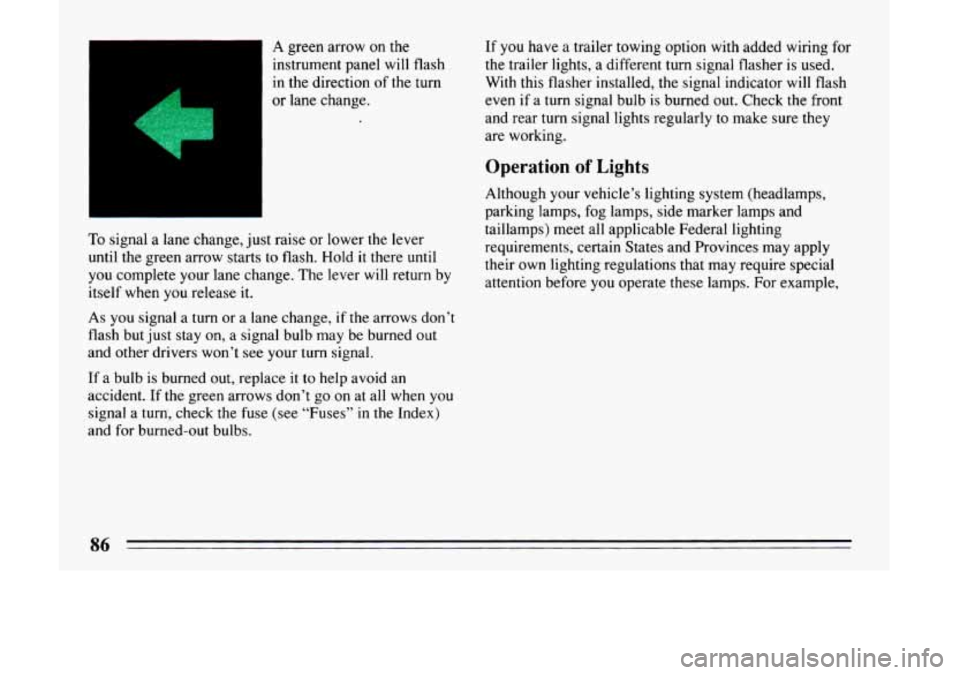
A green arrow on the
instrument panel will flash
in the direction
of the turn
or lane change. If
you have
a trailer towing option with added wiring for
the trailer lights, a different turn signal flasher is used.
With this flasher installed, the signal indicator will flash
even if a turn signal bulb is burned out. Check the front
and rear
turn signal lights regularly to make sure they
are working.
Operation of Lights
To signal a lane change, just raise or lower the lever
until the green arrow starts to flash. Hold
it there until
you complete your lane change. The lever will return by
itself when you release it.
As you signal a turn or a lane change, if the arrows don’t
flash
but just stay on, a signal bulb may be burned out
and other drivers won’t see your turn signal.
If a bulb is burned out, replace it
to help avoid an
accident. If the green arrows don’t
go on at all when you
signal a turn; check the fuse (see “Fuses” in the Index)
and for burned-out bulbs. Although your vehicle’s lighting system
(headlamps,
parking lamps, fog lamps, side marker lamps and
taillamps) meet all applicable Federal lighting
requirements, certain States and Provinces may apply
their own lighting regulations that may require special
attention before you operate
these lamps. For example,
Page 110 of 324

parking brake set, a chime will also come on until you
release the parking brake. If the light and chime stay on
after your parking brake is
fully released, it means you
have a brake problem. If the light and chime come on
while driving, pull
off the road and stop carefully. You
may notice that the pedal is harder to push. Or, the pedal
may go closer to the floor. It may take longer to stop. If
the light is still on, have the vehicle towed for service.
(See “Towing Your Car” in the Index.)
1 &!A CAUTION:
Your brake system may not be working properly
if the brake warning light is on. Rriving with the
brake warning light on can lead to an accident. If
the light is still on after you’ve pulled off the road
and stopped carefully, have the vehicle towed for
service.
Anti-Lock Brake System Warning Light
1-
ANTI
LOCK
With anti-lock, this light will go on when you start your
engine and may stay on for several seconds or
so. That’s
normal. If the light doesn’t come on, have it fixed
so it
will be ready to warn you if there is a problem.
If the light stays on or comes
on when you’re driving,
stop as soon as possible and turn the key off. Then start
the engine
to reset the system. If the light still stays on,
or comes
on again while you’re driving, your Buick
needs service. Unless
the regular brake system warning
light is also
on, you will still have brakes, but not
anti-lock brakes. If the regular brake system warning
light
is also on, see “Brake System Warning Light”
earlier
in this part.
108
Page 147 of 324
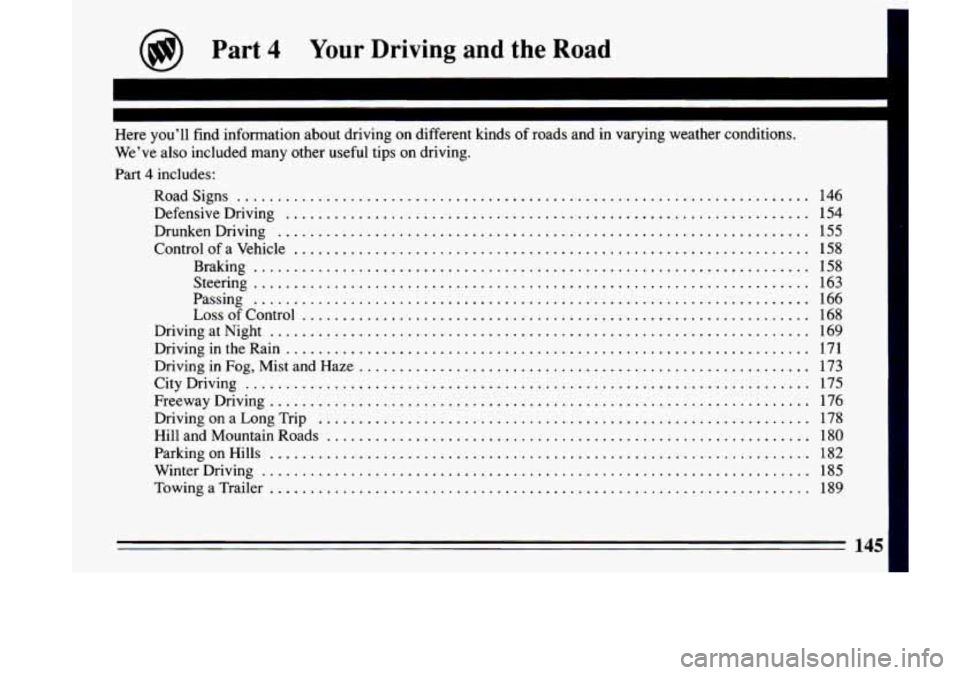
@ Part 4 Your Driving and the Road
Here you’ll find information about driving on different kinds of roads and in varying weather conditions .
We’ve also included many other useful tips on driving .
Part 4 includes:
Roadsigns
..................................................................... 146
DefensiveDriving
................................................................. 154
DrunkenDriving
.................................................................. 155
ControlofaVehicle
................................................................ 158
Braking
..................................................................... 158
Steering
..................................................................... 163
Passing
..................................................................... 166
LossofControl
............................................................... 168
DrivingatNight
................................................................... 169
DrivingintheRain
................................................................. 171
Driving in Fog, Mist and Haze ........................................................ 173
CityDriving
...................................................................... 175
FreewayDriving
................................................................... 176
DrivingonaLongTrip
............................................................. 178
HillandMountainRoads
............................................................ 180
ParkingonHills
................................................................... 182
WinterDriving .................................................................... 185
TowingaTrailer
................................................................... 189
145